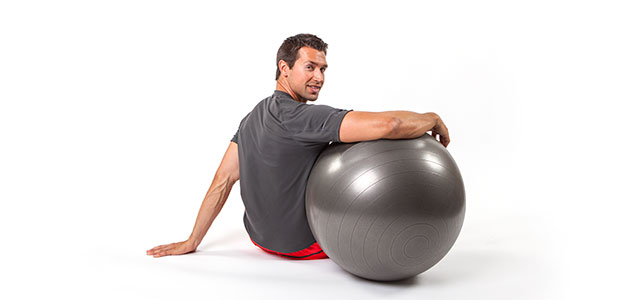
Back pain can be debilitating. These resistance exercises will help you strengthen all the back muscles for pain relief and greater mobility.
Some situations are precursors to back problems. As a youth worker, I occasionally found myself in Family Court in support of a young offender. When one particular judge didn’t like my testimony, he would roar at me, “Bring your toothbrush the next time you make a remark like that. You’ll be going away for a long time.”
When I heard those words, a sharp, disabling pain would shoot through my neck and upper back. It felt as if His Honour was stabbing me between my vertebrae. After one episode of judge-related back pain, I had to referee a hockey game that evening. During the game, I broke up a fight and the pain vanished. That day I learned that judges can be a pain in the neck—and the back—and sometimes a little exercise can be good therapy.
The cost of back pain
We put our backs through a lot of stress as we age, and back pain is an all-too-common result. In Canada, estimated costs of treatment for chronic back pain range from $6 billion to $12 billion per year.
It is important to maintain back strength. As we age, we may lose bone mass in the vertebrae, and the discs between the vertebrae may lose fluid and flexibility. This can cause more chronic pain in the back, and also make us shorter.
Resistance exercise
Resistance exercise prevents bone loss and promotes a pain-free third age. Turn the page for four back maintenance exercises you can try at home using a 55 to 65 cm exercise ball and a resistance tube.
Do 12 repetitions and 4 sets of each.
Hyperextensions
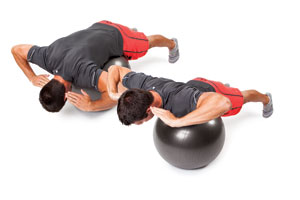
Area targeted: These target the erector spinae muscle that runs parallel to the spine.
- Assume a prone (face down) position on the exercise ball so that the ball is positioned between your hips and chest.
- Brace your feet against the bottom of a wall for leverage.
- Lift your upper body so it’s in a straight line with your legs. Feel the muscles contract in the middle (thoracic) and upper (cervical) regions.
- Extend your arms for more resistance.
- Return to original position.
Reverse Hyperextensions
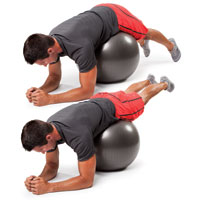
Area targeted: These work the lower (lumbar) back.
- Assume a prone position on the ball with your upper body resting on your forearms and the ball under your hips.
- Lift your legs so they form a straight line with the rest of the body, then lower to starting position.
Tip: Afterward, stretch the back by moving from the prone to the supine (face up) position and doing some ball crunches. This is a good back stretch, as the abdominal muscles work in opposition to the erector spinae. Ball crunches are particularly effective because they combine balance and strength.
Tip: Afterward, stretch the back by moving from the prone to the supine (face up) position and doing some ball crunches. This is a good back stretch, as the abdominal muscles work in opposition to the erector spinae. Ball crunches are particularly effective because they combine balance and strength.
Rowing on the Ball
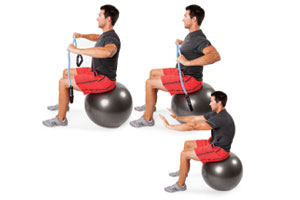
Area targeted: This targets the middle and upper back: the rhomboids and the trapezius, as well as the rear deltoids.
- Sit on the ball and hold the resistance tube close to your chest with elbows out to the sides at shoulder height.
- Pull your elbows back so you can feel all the muscles of the upper back contract. Feel all the muscles between the shoulder blades working.
- While you’re doing this and you’re on the ball anyway, try to scribe a figure of eight with your hips to work on balance.
- Stretch by pushing your arms forward, separating your shoulder blades as if you’re doing a push-up, hold briefly, then return to starting position.
Shoulder Shrugs
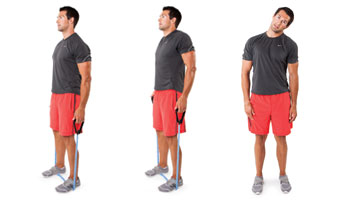
Area targeted: These work the trapezius, or the “pain in the neck” muscle that originates at the skull and cervical vertebrae and inserts at the shoulder blades.
- Stand on the resistance tube with the handles in your hand in a manner that offers resistance as you lift your shoulders toward your ears.
- Roll your shoulders backward 4 times. Feel the exercise working the muscle group between your shoulders and neck.
- Stretch by tilting your ear to your right shoulder and hold, then tilt your opposite ear to your left shoulder and hold briefly.
How often should I exercise?
Exercise every second day because sore backs can be debilitating. They can interfere with all aspects of life, including mental health. Conversely, a pain-free body can lead to a positive outlook and good mental health.
Walk off back pain
Researchers have noted the positive therapeutic effects of walking programs for lower back pain sufferers. People who walked fared as well or better than those in muscle strengthening programs.
Walking is an inexpensive activity that doesn’t require fancy gym equipment. It also gives your body a break from all the sitting it does at our desks, while driving, and in front of the television set. Walking strengthens the muscles of the core, including the back. Some research indicates that simply standing can reduce back and neck pain.
Go for a brisk walk for 20 to 40 minutes, two to three times a week. If you suffer from back pain, start with a short walk and gradually increase the distance as your back gets stronger.
Stretches for the back
Hold these poses for about 30 seconds each at the end of your workout.
Lower back
- Lie on your back with your legs 90 degrees to your hips and your knees together and bent at 90 degrees.
- Let your legs and hips fall to the right, stretching the muscles of the lower erector spinea.
- Repeat on the left side.
Upper back
- Sit on the floor with the soles of your feet together and your knees up.
- Cross your arms and hold knees with opposite hands.
- Push your knees toward the floor and feel the stretch in the upper back.
- Intensify by pressing right ear, then left ear, toward your shoulders.
Middle back
- Start in the same position as above, but shift your hands to your shins.
- Round your back as you pull back on your shins.




































